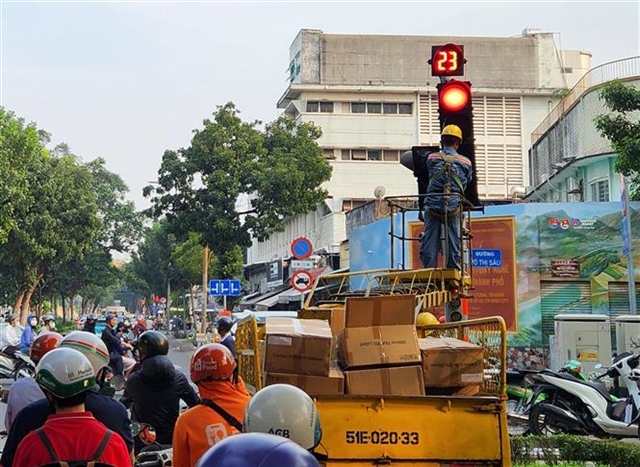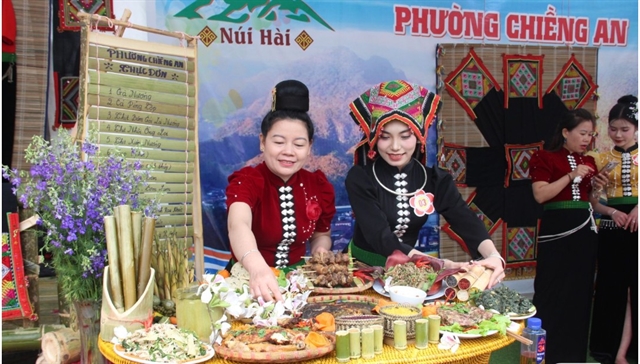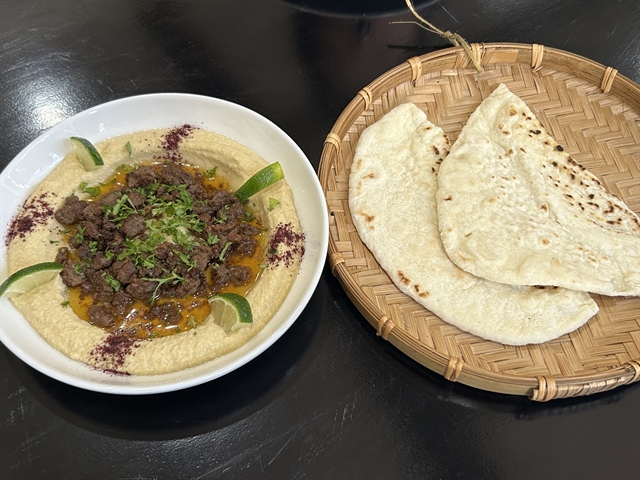
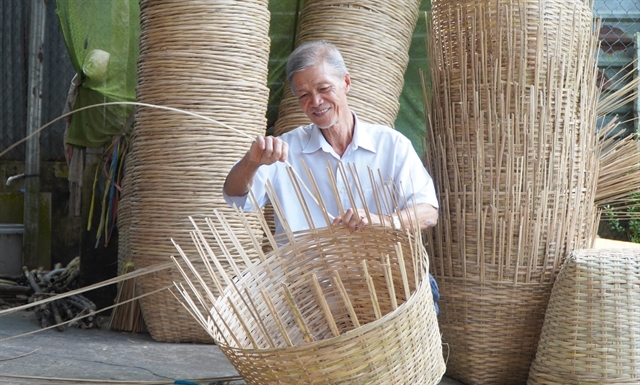 |
| An artisan makes cần xé (a type of large bamboo basket) in Đồng Tháp Province’s Lai Vung District. Basket knitting is one of the province’s traditional crafts. — VNA/VNS Photo Nhựt An |
ĐỒNG THÁP — Households and commercial establishments in Đồng Tháp Province’s traditional craft villages are upgrading their production methods to meet market demand and boost their incomes.
The Cửu Long (Mekong) Delta province is well-known for its traditional crafts, including mat weaving in Lấp Vò District, Lai Vung nem (fermented pork with garlic, pepper, salt, and red chilli) making and boat making in Lai Vung District.
Lai Vung is home to six recognised traditional crafts: nem making, boat making, paper flower growing, lờ and lợp (bamboo tools for fishing) knitting, cần xé (large bamboo baskets) knitting, and bội (bamboo coops for chickens) knitting.
Situated between the Tiền and Hậu rivers, two major tributaries of the Mekong, Lai Vung has long relied on its dense river network for economic activities, including wooden boat production and bamboo fishing tool making.
However, rapid technological advancements and infrastructure development have significantly impacted these traditional crafts.
The construction of roads and the growing popularity of composite boats have reduced demand for wooden boats, while decreasing flood levels in recent years caused by changes in the Mekong River’s flow have diminished aquatic resources, leading to a decline in the need for bamboo fishing tools.
As a result, many households in these traditional craft villages have been forced to shift to alternative occupations.
To counteract this trend and preserve their heritage, artisans are finding innovative ways to adapt their production.
Nguyễn Văn Tốt’s family has been making wooden boats for four generations in Long Hậu Commune’s boat making village.
Facing declining demand, he switched to making miniature souvenir boats. His handcrafted models, sold across Việt Nam and internationally, range in price from VNĐ400,000 (US$16) to VNĐ6 million ($235), and generate around VNĐ100 million ($3,900) in yearly revenues.
He takes pride in maintaining the craft and contributing to the village’s cultural preservation.
Recognising the significance of this trade, the Ministry of Culture, Sports and Tourism has designated boat making in Long Hậu Commune a national intangible heritage.
To sustain traditional crafts, local authorities have rolled out a number of support policies that encourage artisans to modernise production, improve quality and integrate their crafts into the country’s “One Commune – One Product” (OCOP) programme.
Lai Vung also has other traditional crafts with significant development potential, including straw mushroom cultivation and rice flake, corn flake and rice paper production.
To further support these industries, the district has introduced various initiatives, including an annual festival to celebrate and promote traditional crafts.
Nguyễn Hữu Nghĩa, chairman of the Lai Vung People’s Committee, said the festival provided a platform for artisans, businesses and tourists to experience and engage with traditional crafts.
It also fostered stronger connections between producers and buyers, enhancing the long-term sustainability of these industries.
Võ Hoàng Cương, secretary of the Lai Vung District Party Committee, announced plans to establish a weekly craft village showcase to provide artisans with opportunities to present their products, seek business partnerships and attract tourists interested in purchasing traditional craft items and experiencing their production first-hand.
Enhancing production efficiency
Traditional craft villages across Đồng Tháp have been investing in modern machinery to boost productivity while also implementing wastewater treatment systems to protect the environment.
Lấp Vò District, for example, has four recognised craft villages and eight recognised traditional craft villages that make fishing nets, mats, bamboo baskets, and other handicrafts.
These villages support over 1,500 households and employ some 3,500 workers, and generating revenues of VNĐ125 billion ($4.9 million) last year.
Most mat-making households in Định An and Định Yên communes have installed weaving machines, significantly increasing productivity while simultaneously implementing septic tank wastewater treatment systems to ensure environmental sustainability.
Nguyễn Thị Kim Quý, a mat weaver in Định Yên Commune with over 50 years of experience, noted that while her family initially wove mats manually, the introduction of machines has allowed them to produce more efficiently.
“I take great pride in preserving and promoting my village’s mat weaving heritage.”
Trần Hoàng Nam, deputy chairman of the Lấp Vò People’s Committee, said the integration of modern machinery has led to an improvement in the quality of products and more diverse designs, allowing local crafts to better meet consumers’ demands.
The district has actively supported producers by helping them acquire production equipment, access soft loans, register brand names, and participate in trade promotion activities to expand both domestic and international markets.
Moving forward, Lấp Vò will continue to encourage production establishments in craft villages to adopt advanced manufacturing techniques while also focusing on enhancing product packaging and branding to increase competitiveness.
Preserving Lai Vung nem tradition
Đặng Thị Ngọc Thuý, owner of the Nem Hoàng Khánh Establishment in Lai Vung District’s Tân Thành Commune, has been producing nem for 20 years.
To uphold and further develop the Lai Vung nem brand, she has prioritised product quality and food safety and hygiene and switching to machinery to increase efficiency.
Her establishment currently sells 5,000- 6,000 pieces of nem daily.
Lai Vung’s nem-making tradition, which spans over 60 years, remains a crucial industry in the region.
The district is home to 20 well-known nem-making establishments, collectively generating annual revenues of VNĐ60 billion ($2.4 million).
Some of these businesses have even achieved three- and four-star OCOP certification, further reinforcing their reputation for quality.
Promoting craft villages through tourism
To ensure the sustainability of these traditional crafts, Đồng Tháp authorities have been integrating vocational training for artisans and knowledge-sharing initiatives for local officials.
They have also studied successful models in other provinces to adopt best practices for preserving and promoting craft villages.
Traditional craft villages in Đồng Tháp have increasingly attracted both local and international tourists. One of the most notable examples is the Sa Đéc Flower Village in Sa Đéc City, where 2,300 households cultivate around 2,000 varieties of flowers and ornamental plants.
The village exports its products to Cambodia, Laos, China, and other countries and draws thousands of visitors daily during the Tết (Lunar New Year) festival, when every Vietnamese household buys flowers to decorate their houses.
To further develop this sector, local authorities are implementing initiatives that combine craft village preservation with tourism promotion.
Lai Vung District is for instance developing community-based tourism initiatives that allow visitors to explore fruit orchards, flower gardens and traditional craft villages.
This programme provides tourists with an immersive experience, allowing them to better understand the cultural significance and intangible heritage of Đồng Tháp’s traditional crafts.
By modernising production, integrating tourism, and ensuring the sustainability of traditional industries, Đồng Tháp’s craft villages are poised for long-term growth while preserving their rich cultural heritage. — VNS

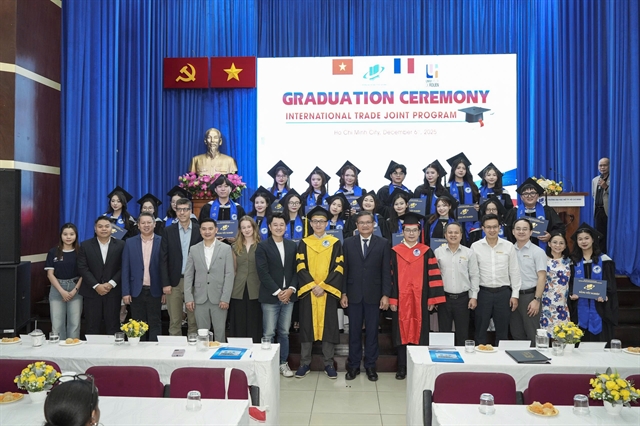







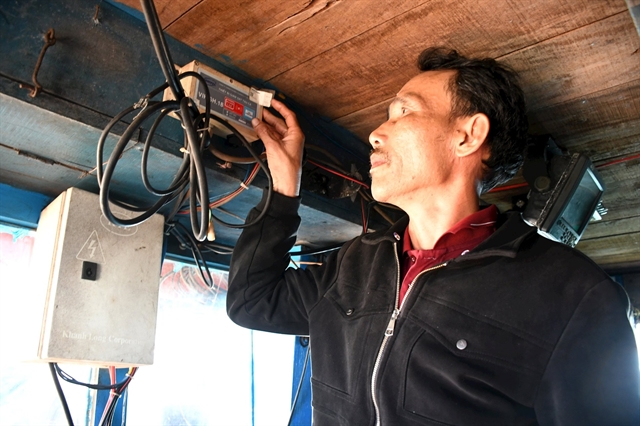


.jpg)
